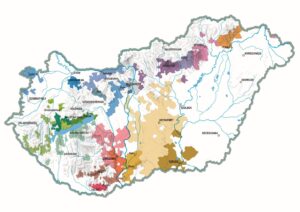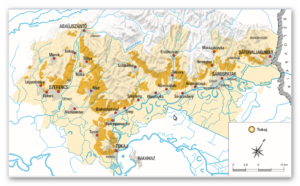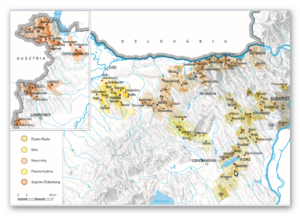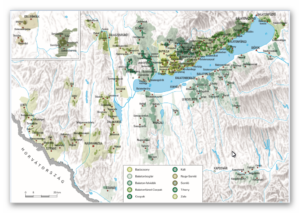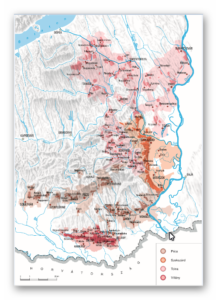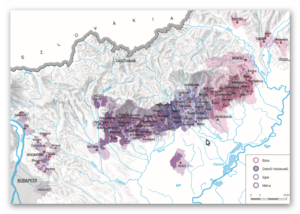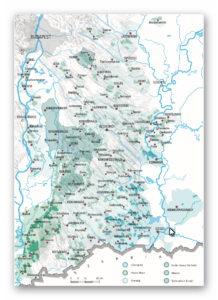Simple, clear and concise answers are what people want to read and listen to. I remember when teaching at the Austrian Wine Academy (Weinakademie Österreich) I used to draw a matrix with the individual GI´s and their main attributes like soil, climate, size, most important villages, grape varieties and style. Something which students started to be using as well when highlighting certain areas, simple and straight forward. While this is superficial as it does not go down into depth of reasoning but on the basic level I found it absolute perfect.
Why not have something simple, clear and concise drawn for the Hungarian GI´s? Since my handwriting may not adequate I came up with the second best solution using the word processors assistance.
Below you the individual wine districts of Hungary within their respected greater region.
Highlighting the main attributes such as:
- Soil
- Climate
- The actual surface where permitted grape varieties are planted in hectare
- Major varieties and their respected size in hectare.
- Major communes
- Key style
Now this later is sometimes rather difficult to confine in those cases when the product specification allows a huge number of varieties, categories and therefore styles to be made. But you´ll get the point…
Tokaj Region
| Wine district (PDO) | Tokaj |
| Soil | Mainly of volcanic origin, from andesite over to a variety of tuff and red clay. Around Tarcal and Tokaj town its predominant loess. |
| Climate | Unique climate as the botrytis (noble rot) sweet wine production goes back to the XVI. century. The main rivers of Bodrog and Tisza provide the humidity needed and the Zemplén mountain range supports as a protective shelter. Average rainfall: 640 mm, avg. temperature: 11,2 °C. Micro-climate is key determining factor for aszú (noble rot) which usually is more predominant at the lower slopes, while high quality raw material for dry wines are sought after usually on the top slopes. |
| Surface of permitted grape varieties (in hectare) | 5685 |
| Major grape varieties | Furmint (3780 ha), Hárslevelű (1125 ha), Muscat Lunel (858 ha) |
| Major municipalities | Mád, Sárospatak, Tarcal, Tokaj, Tolcsva |
| Key styles | Aszú the noble sweet wine with high acidity, richness, low alcohol, luscious texture, complexity of fruit, spice, never-ending finish stands out. Szamodorni (botrytis and non botrytis grapes picked together) made dry (nutty, almond, tangy, floor like, full bodied) and sweet (rich texture, fruit driven, almost full bodied with a grip) perhaps the oldest style of the region. Dry wines made either in a rather simple style or top notch mineral driven, tight structure, spice and stone fruit led, whereby the single vineyard may dominate over variety or blend. Sparkling wines and Furmint/Hárslevelű blends are up and coming. |
Felső Pannon (Upper Pannon) Region
| Wine district (PDO) | Etyek – Buda | Mór | Neszmély | Pannonhalma | Sopron |
| Soil | Brown forest floor with limestone. The Buda district has more dolomite and limestone, while around Etyek marl, loess and limestone, while around Velence (lake) there is more granite and loess. | Dominated by loess and limestone along the fault line of the Bakony and Vértes mountain range with some clay. | Along the Western side mainly marl and brown forest floor, while the Eastern part has more limestone, loess, sandstone and dolomite. Around Neszmély town limestone, marl dominates. | Mainly crystal soil, led by limestone, loess, sandy-loess. | Limestone, with stony soils, schist and loess. |
| Climate | Usually cool climate with plenty of wind movement (N and NW wind), the area around Velence Lake is warmer. Average rainfall: 650 mm, average temperature: 10 °C. | Cool climate along the Mór basin, influenced heavily by the Bakony and Vértes mountain range. Average rainfall: 625 mm, average temperature: 10 °C. | Situated along the right side of the Danube, mainly along the West side of the Gerecse. Close to the river the micro climate is very much influenced by the water. Average rainfall: 640 mm, average temperature: 10 °C. | Influenced by the Bakony range and Marcali basin with N-W winds. Average rainfall: 600 mm, average temperature: 10 °C. | The Fertő Lake (Lake Neusiedl) plays a major role with a moderating effect on temperature yet the average rainfall as well as the wind is usually higher and stronger in the area leading to lower humidity levels. Vineyards are between 100-400 m with strong micro- and meso differences, especially between Sopron and Kőszeg. Average rainfall: 600 mm, average temperature: 11,2 °C. |
| Surface of permitted grape varieties (in hectare) | 1541 | 486 | 961 | 609 | 1579 |
| Major grape varieties | Chardonnay (218 ha), Irsai Olivér (152 ha), Grüner veltliner (130 ha), Pinot noir (117 ha), Sauvignon blanc (114 ha) | Ezerjó (110 ha) , Chardonnay (62 ha), Traminer (38 ha), Sauvignon blanc (36 ha), Riesling (34 ha) | Chardonnay (184 ha), Pinot gris (140 ha), Sauvignon blanc (76 ha), Királyleányka (70 ha) | Olaszrizling (150 ha), Irsai Olivér (69 ha), Riesling (64 ha), Chardonnay (40 ha) | Kékfrankos (850 ha), Zweigelt (151 ha), Grüner veltliner (113 ha), Cabernet sauvignon (100 ha) |
| Major municipalities | Budafok, Budakeszi, Budajenő, Etyek, Nadap, Sukoró | Mór, Csókakő, Csákberény, Pusztavám | Neszmély, Ászár, Császár, Vértesszőlős, Dunaszentmiklós, Tokod | Pannonhalma, Ravazd, Ecs, Nyúl | Sopron, Fertőrákos, Kőszeg, Cák, Vaskeresztes |
| Key styles | Famous for sparkling wines as well as refreshing, crisp, lively whites. Varietal driven style with a clean bright flavour profile. | White wines with high acidity, medium full body, sometimes oily and square like texture and bold fruit, ageing capability given. Ezerjó and Chardonnay blends are something to look forward as well. | Varietal driven, mainly refreshing, fruity light to medium full bodied white wines. | Refreshing acidity, usually white wines with fruit driven and varietal characteristics. | Kékfrankos is definitely the leading variety. While a number of other varieties are to be found with some blends as well, but to simplify lets just focus on Kékfrankos. Usually lighter colour, refreshing acidity, medium tannin with red berry flavours and delicate spicy tone. Medium full bodied and distinctively brisk aromas support a unique style. |
Balaton Region
| Wine district (PDO) | Badacsony | Balatonboglár | Balatonfüred-Csopak | Balaton-felvidék | Nagy Somló | Zala |
| Soil | Volcanic basalt with a mixture of sandstone, brown forest floor and clay. | Clay and sand with low lime content sandstone from the Pannon sea. | Very diverse soil combination. Clay, sandstone, schist, red clay, mineral rich soils. | The Balaton-felvidék (Balaton highland) district can be divided into several smaller units, as along the Káli basin (hearth land Balaton) the soil consists of limestone, dolomite, tuff, clay and sandstone; while along the Keszthely mountain range in the West its predominantly loess, marl and brown forest floor with no volcanic tuff amongst many others. | The so-called Great Somló (Nagy Somló in Hungarian) is based around three volcanic mountains, the Somló, the Ság, and the Kis-Somlyó. The soil is predominantly basalt, basalt tuff, limestone tuff with a mix of sandstone and clay. | Bordering the Croatian border (Mura sub zone), as well as the Kis Balaton and hearth land of the Zala County. Mixture of clay, brown forest floor, sandstone with loess. |
| Climate | The climate is much influenced by the Balaton Lake from the South and from the North the Bakony mountain range, supporting a classic continental climate. The average rainfall: 620 mm, average temperature: 11,2 °C. | Classic continental climate, influenced to a certain extend from the Lake Balaton. The district stretches 50 km along the Southern shore of the lake reaching 20-25 km into the Somogy hills. Vineyards situated South West. Average rainfall: 600 mm, average temperature: 10,6 °C with high sun shine hours (2000+). | Cool air movement from the North, the Bakony mountain range and influenced to the South by the Lake Balaton. Average rainfall: 660 mm, average temperature: 11,5 °C. | Classic continental climate, however similar to the topography the “hearth land” at Káli basin is much influenced by the Balaton, while along the Keszthely mountain range the Bakony as well as the Balaton play less of a role. Average rainfall: 650 mm, average temperature: 11,5 °C. | Warm temperature from the Kisalföld, while cool winds from the Bakony range as well as the Marcal River influenced the area. Average rainfall: 675 mm, average temperature: 10,5 °C. | Continental climate with some sub Mediterranean influence from the Adria and the Alps. Average rainfall: 675 mm, average temperature: 10 °C. |
| Surface of permitted grape varieties (in hectare) | 1193 | 3475 | 1888 | 785 | 453 | 493 |
| Major grape varieties | Olaszrizling (595 ha), Pinot gris (195 ha), Pinot noir (76 ha), Riesling (53 ha), Kéknyelű (42 ha) | Chardonnay (398 ha), Irsai Olivér (385 ha), Merlot (334 ha), Grüner veltliner (300 ha), Királyleányka (294 ha) | Olaszrizling (738 ha), Kékfrankos (161 ha), Pinot gris (122 ha), Cabernet sauvignon (102 ha) | Olaszrizling (346 ha), Pinot gris (91 ha), Chardonnay (60 ha), Irsai Olivér (51 ha), Kékfrankos (39 ha), Grüner veltliner (26 ha) | Olaszrizling (147 ha), Juhfark (100 ha), Furmint (79 ha), Hárslevelű (35 ha) | Other varieties (277 ha), Olaszrizling (70 ha), Cabernet sauvignon (60 ha) |
| Major municipalities | Badacsonytördemic, Badacsonytomaj, Hegymagas, Szigliget, Nemesgulács, Ábrahámhegy, Káptalantóti | Balatonboglár, Balatonlelle, Szőlősgyörök, Kötcse, Kéthely, Lengyeltóti | Balatonfüred, Csopak, Szentantalfa, Tagyon, Balatonfőkajár, Tihany, Balatonakali, Balatonszőlős, Pécsely, Dörgicse | Köveskál, Mindszentkálla, Szentbékálla, Monostorapáti (Káli sub zone), Rezi, Balatonederics, Lesencetomaj, Hévíz-Egregy (Keszthely mt. sub zone), Sümeg. | Somlóvásárhely, Somlójenő, Somlószőlős (Mt. Somló), Kissomyló, Celldömölk | Csörnyeföld, Becsehely, Nagyrada, Szentgyörgyvár, Zalaszentgrót |
| Key styles | The key hills are: Badacsony, Szent György, Szigliget, Haláp, Hegyesd, Csobánc, Gulács, Tóti, and Hegyestű all have different characters based on climate and soil, mainly. However, generally speaking the wines here show high acidity, oily texture, medium to full bodied with a stony, creamy mid-palate tone with a hint of saltiness perhaps as well. | Hard to define, virtually everything. From sparkling wine to, light aromatic whites all the way to serious bold, full bodied reds. | Very diverse area considering separate entities such as Nivegy valley, Balatonkenese, and the area around Balatonfüred as well as Tihany PDO and Csopak PDO. Later two dominated by red wine (Tihany) and Csopak only by Olaszrizling are completely different to the rest of the region. Hence one word would describe it as: diverse. And its worth to look at them as smaller units. | Hard to generalize, very much dependant on the micro site, yet usually along the Káli area mineral driven white wines with crisp, salty, lively tone. | Usually bold, restrained fruit, high acidity white wines with a distinctive minerality, oily, salty texture, full bodied. | Virtually impossible to define, usually fresh acidity with medium body. Much depending on the bottling producer and the actual place.
|
Pannon Region
| Wine district (PDO) | Pécs | Szekszárd | Tolna | Villány |
| Soil | The Western side shares more loess and at top levels limestone, sandstone and schist. While the majority of the area is based on clay and limestone. The Eastern side is predominantly loess only. | While the topography of the area is diverse due to the different hills, ridges running across the vine growing district, yet when it comes to the actual soil composition, its virtually loess only. Sometimes mixed up with some sandstone. | Mainly loess with some clay and limestone. The Northern part shares predominantly brown forest floor. | Mt. Villány is based on limestone and dolomite with clayey loess. |
| Climate | Mt. Mecsek plays an important role. Sub Mediterranean climate prevails; it’s generally speaking a warm area with Western winds and more precipitation during summer. Average rainfall: 600 mm, average temperature: 10,7 °C. | Continental; the Danube river has a certain influencing effect; the area is regarded continental with warm overall temperature making it virtually a “red wine region” only. The micro- and meso climate due to the topography play an important role. Average rainfall: 600 mm, average temperature: 11,3 °C. | Fairly warm area influenced partly by the Danube and other smaller water surfaces. Average rainfall: 590 mm, average temperature: 11 °C. | Continental and Mediterranean climate clash in the area supporting a rather warmer average temperature with a North and NW dominating wind. Average rainfall: 700 mm, average temperature: 11 °C. |
| Surface of permitted grape varieties (in hectare) | 565 | 2252 | 2226 | 2423 |
| Major grape varieties | Olaszrizling (67 ha), Chardonnay (58 ha), Müller Thurgau (35 ha), Cirfandli (22 ha) | Kékfrankos (660 ha), Merlot (385 ha), Cabernet franc (254 ha), Cabernet sauvignon (251 ha), Kadarka (82 ha) | Kékfrankos (365 ha), Chardonnay (225 ha), Grüner veltliner (220 ha), Merlot (162 ha) | Cabernet sauvignon (432 ha), Portugieser (355 ha), Cabernet franc (335 ha), Merlot (296 ha), Kékfrankos (282 ha) |
| Major municipalities | Szigetvár, Pécs, Mecseknádasd, Bóly, Mohács | Szekszárd, Decs, Bátaszék, Báta | Tolna, Simontornya, Tamási, Bonyhád | Villány, Nagyharsány, Kisharsány, Siklós |
| Key styles | The white wines dominate with fresh fruity tones medium full body. Notable the ripe and oily, (sometimes) sweet character of Cirfandli grape. The reds share fresh acidity with medium tannins with a certain herbal element. | Kékfrankos, Kadarka as single varietal wines and Szekszárdi Bikavér which must be a blend. The Bikavérs here share fruity, spicy notes with medium full body, discrete tones from the oak, moderate acidity and tannins, yet certain freshness and harmony prevails in these local blends whereby Kékfrankos most dominate (min. 40%) and Kadarka must be used as well. | The white wines share freshness, ripe fruit and varietal character. While the red wines have usually a moderate tannin support, yet highlighted by fruity, spicy tones. | Arguably a red wine area where light juicy, fruity red wines based on Portugieser are made and referred to it as “Redy”. Special emphasize is put on the Cabernet franc, making bold, rich, dark fruit and spice led, full bodied reds. |
Felső Magyarország (Upper Hungary) Region
| Wine district (PDO) | Bükk | Eger | Mátra |
| Soil | Mainly along the Southern side of the Mt. Bükk with a mixture of rhyolite tuff, loess, black clay soils. | Very diverse area in terms of geology. The old saying goes that on the Western side on more rhyolite clay was rather suitable for white wines, while the Eastern side more limestone better for black grape varieties. Several single vineyards have distinctive soil attributes. Rhyolite tuff, dacite, volcanic soil as well as clay and sand stone, limestone and schist. | Loess and sandy soils usually be found on the Southern lower levels, in the Northern sites and top slopes have more brown forest floor, clay based and some sites even have volcanic soils like andesite, which makes this large district fascinating as well. |
| Climate | The majority of the grapevines are between 150-250 m of sea level. The climate is very much influenced by the Mt. Bükk protecting from Northern winds, winters can be quite intense. Average rainfall: 550 mm, average temperature: 10 °C. | Sheltered in the North from cold winds and relatively open to the South. Average rainfall: 590 mm, average temperature: 10,6 °C. | Classic continental climate with warm summers and cold winters. Since it’s a fairly wide area going all the way to the outskirts of Budapest, the capital (Budapest-Rákosliget) as well as the Danube (Vác), it much depends on the actual site. Average rainfall: 630 mm, average temperature: 10,5 °C. |
| Surface of permitted grape varieties (in hectare) | 898 | 5618 | 6012 |
| Major grape varieties | Kékfrankos (200 ha), Leányka (166 ha), Chardonnay (60 ha), Zweigelt (54 ha), Olaszrizling (52 ha) | Kékfrankos (1270 ha), Merlot (522 ha), Cabernet sauvignon (470 ha), Blauburger (313 ha), Hárslevelű (280 ha), Olaszrizling (250 ha), Leányka (246 ha) | Müller Thurgau (618 ha), Kékfrankos (605 ha), Pinot gris (560 ha), Muscat Ottonel (528 ha), Chasselas (445 ha), Olaszrizling (430 ha) |
| Major municipalities | Miskolc, Tibolddaróc, Edelény, Emőd, Bükkaranyos, Bogács | Eger, Egerszalók, Egerszólát, Demjén, Verpelét, Noszvaj | Gyöngyös, Gyöngyössolymos, Abasár, Gyöngyöspata, Markaz, Hatvan, Szada |
| Key styles | Refreshing, crisp white wines with fine fruit and even some minerality. The red wines are moderate in tannins, but fresh in acidity, clean fruit and even here a certain salty minerality may be found. | Egri Bikavér is the red blend which must be based on Kékfrankos, while the Egri Csillag could be referred to it as a white alternative a cuvée based on “local” varieties, aromatic varieties are limited. Debrői Hárslevelű PDO is sub zone based on the aromatic variety producing fruit sometimes even sweet wines. | At best volcanic driven, gritty, salty, crisp acidity with clear and precise fruit, spice and complexity. At the other end of the spectrum, crisp, varietal character, moderate finish. |
Duna (Danube) Region
| Wine district (PDO) | Csongrád | Hajós-Baja | Kunság |
| Soil | Fairly flat area with predominantly sandy soil with some loess. | The hills (max. 150 m) gently rolling run NW and SE in direction. It’s predominantly loess with low lime content. | Generally speaking its sand with some brown forest soil, loess. Low water retention but prized for phylloxera resistance due to the high quartz content. The biggest vine growing area of Hungary between the Great Plain and Danube-Tisza area. Stretching through 5 counties and 111 municipalities. |
| Climate | Warm summers, cool winters with over 2200 hours of sunshine. Average rainfall: 475 mm, average temperature: 10,6 °C. | Classical continental climate prevails in the area with an average rainfall: 475 mm, average temperature: 11,5 °C. Frost may be a problem during winter and spring. | Relatively high sun shine hours with low precipitation, classic continental climate. Average rainfall: 475 mm, average temperature: 11,2 °C. |
| Surface of permitted grape varieties (in hectare) | 812 | 1463 | 11259 |
| Major grape varieties | Kékfrankos (288 ha), Cserszegi fűszeres (85 ha), Kövidinka (80 ha), Riesling (80 ha) | Cserszegi fűszeres (437 ha), Kékfrankos (395 ha), Bianca (125 ha), Cabernet sauvignon (110 ha) | Bianca (5141 ha), Cserszegi fűszeres (3135 ha), Kékfrankos (2500 ha), Aletta (1940 ha), Kunleány (740 ha), Zala gyöngye (733 ha), Riesling (568 ha), Kövidinka (520 ha), Generosa (493 ha), Arany sárfehér (474 ha) |
| Major municipalities | Ásotthalom, Mórahalom, Pusztaszer, Csongrád | Hajós, Baja, Csátalja, Császártöltés, Borota, Érsekcsanád | Kecskemét, Soltvadkert, Kiskörös, Monor, Kecel, Izsák |
| Key styles | Light, simple fruity wines are produced but currently very little is actually bottled. | Wide ranges of styles are permitted in the product specification. However, usually light to medium body dry white- and red wines are the most common. Clear and precise fruit with moderate acidity and soft tannins at the red end and agreeable finish. | Light bodied white and red wines with varietal character, meant for early consumption. Soltvadkert PDO produces sparkling, dry and sweet wines from de Ezerjó variety which can show high acidity sometimes with fruity and even oily texture. The Izsáki Arany Sárfehér PDO makes sparkling and white wines from the Sárfehér variety which resemble sometimes quince apple, wild pear notes with fresh acidity. |
Source: Map are low resolution only, higher available at Ministry of Agriculture, Hungary
Data (e.g. hectare size) from Ministry of Agriculture database


